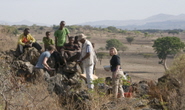Following the 2010 eruption of the Eyjafjallajökull volcano in Iceland, the National Risk Register now lists volcanic hazards at the highest priority level. Volcanic hazard assessment draws together scientific knowledge of volcanic processes, observational evidence and statistical modelling to assess and forecast hazard and risk. Researchers at the University of Bristol have been central to the development of local, regional and global volcanic risk modelling over recent decades. One aspect of ongoing research is to develop a strategy for devising and implementing hazard assessments in an operational environment, to provide decision support during a volcanic crisis.
 |
| Cabot Professor Willy Aspinall demonstrating the application of Expert Elicitation in volcanic hazard modelling at the OTVHA workshop, Vienna, April 2014 |
Last week, I organised a workshop on Operational Techniques for Volcanic Hazard Assessment. The 2-day workshop, held in Vienna, Austria and supported by the European Geosciences Union and the Cabot Institute, brought together researchers from 11 institutions in eight countries to explore current practice in methods applied to operational and near-real time volcanic hazard assessment. I was assisted in organising by Dr Jacopo Selva of INGV in Bolognia and speakers included Cabot Institute members Professor Willy Aspinall and Dr Thea Hincks, Dr Richard Luckett of the British Geological Survey and Dr Laura Sandri, of INGV, Italy.
There is a real gap between our ability to monitor and understand volcanic processes and our capacity to implement that understanding in a way that is useful operationally. In this workshop, we were able to bring together some of the leading researchers from around the world to explore how different tools and techniques are deployed. Better integration of these tools is essential for volcanic hazard forecasting to be useful for risk management.
The workshop involved discussion sessions and practical demonstrations of tools for real-time monitoring alerts, the use of expert judgment, Bayesian event tree scenario modelling and Bayesian belief network inference tools. Dr Mike Burton from INGV Pisa, who took part in the workshop, said,
“It’s really important for volcanologists to engage with how our science can be adapted and incorporated in hazard assessments. The OTVHA workshop was a really useful exercise in exploring how our knowledge and uncertainty can be assimilated for real time decision support.”
 |
| Monitoring a volcano in Ethiopia |
My research in Bristol concerns the interface between volcano monitoring data and hazard scenario models and I felt the workshop was a great success. A few groups have developed approaches to modelling volcanic hazard and risk. This workshop provided a great forum for detailed discussion of how these tools and techniques can be combined and compared. As scientists, we need to understand how to optimise and communicate our model output to be useful for decision makers.
Developing tools that are both scientifically and legally defensible is a major challenge in natural hazard science. The idea of organising the OTVHA workshop was to further explore the opportunities in addressing these challenges, which are central to the mission of the Cabot Institute. We’ve already started planning for the next workshop!
The OTVHA workshop was followed up with an associated session at the EGU General Assembly meeting, ‘Advances in Assessing Short-term Hazards and Risk from Volcanic Unrest or Eruption’, with a keynote presentation by Prof Chuck Connor on assessment of volcanic risk for nuclear facilities.
——————————–
This blog is written by Cabot Institute member Henry Odbert, School of Earth Sciences, University of Bristol.
